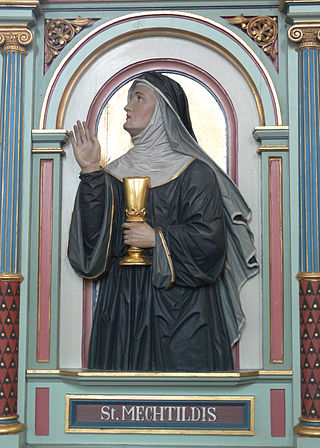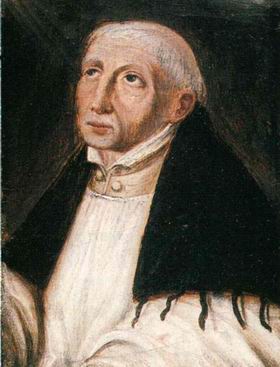Related Research Articles

The Medieval Inquisition was a series of Inquisitions from around 1184, including the Episcopal Inquisition (1184–1230s) and later the Papal Inquisition (1230s). The Medieval Inquisition was established in response to movements considered apostate or heretical to Roman Catholicism, in particular Catharism and Waldensians in Southern France and Northern Italy. These were the first movements of many inquisitions that would follow.

Mechthildof Magdeburg, a Beguine, was a Christian medieval mystic, whose book Das fließende Licht der Gottheit is a compendium of visions, prayers, dialogues and mystical accounts. She was the first mystic to write in Low German.

The Council of Vienne was the fifteenth ecumenical council of the Catholic Church and met between 1311 and 1312 in Vienne, France. One of its principal acts was to withdraw papal support for the Knights Templar at the instigation of Philip IV of France. The Council, unable to decide on a course of action, tabled the discussion. In March 1312 Philip arrived and pressured the Council and Clement to act. Clement passed papal bulls dissolving the Templar Order, confiscating their lands, and labeling them heretics.

John van Ruysbroeck, original Middle Dutch name Jan van Ruusbroec, was an Augustinian canon and one of the most important of the medieval mystics of the Low Countries. Some of his main literary works include The Kingdom of the Divine Lovers, The Twelve Beguines, The Spiritual Espousals, A Mirror of Eternal Blessedness, The Little Book of Enlightenment, and The Sparkling Stone. Some of his letters also survive, as well as several short sayings. He wrote in the Dutch vernacular, the language of the common people of the Low Countries, rather than in Latin, the language of the Catholic Church liturgy and official texts, in order to reach a wider audience.

Johannes Tauler OP was a German mystic, a Roman Catholic priest and a theologian. A disciple of Meister Eckhart, he belonged to the Dominican order. Tauler was known as one of the most important Rhineland mystics. He promoted a certain neo-platonist dimension in the Dominican spirituality of his time.

Henry Suso, OP was a German Dominican friar and the most popular vernacular writer of the fourteenth century. Suso is thought to have been born on 21 March 1295. An important author in both Latin and Middle High German, he is also notable for defending Meister Eckhart's legacy after Eckhart was posthumously condemned for heresy in 1329. He died in Ulm on 25 January 1366, and was beatified by the Catholic Church in 1831.

The Beguines and the Beghards were Christian lay religious orders that were active in Western Europe, particularly in the Low Countries, in the 13th–16th centuries. Their members lived in semi-monastic communities but did not take formal religious vows; although they promised not to marry "as long as they lived as Beguines", to quote an early Rule of Life, they were free to leave at any time. Beguines were part of a larger spiritual revival movement of the 13th century that stressed imitation of Jesus' life through voluntary poverty, care of the poor and sick, and religious devotion.
Quietism is the name given to a set of contemplative practices that rose in popularity in France, Italy, and Spain during the late 1670s and 1680s, particularly associated with the writings of the Spanish mystic Miguel de Molinos, and which were condemned as heresy by Pope Innocent XI in the papal bull Coelestis Pastor of 1687. "Quietism" was seen by critics as holding that man's highest perfection consists in a sort of psychical self-annihilation and a consequent absorption of the soul into the Divine Essence even during the present life.
The Formicarius, written 1436–1438 by Johannes Nider during the Council of Florence and first printed in 1475, is the second book ever printed to discuss witchcraft. Nider dealt specifically with witchcraft in the fifth section of the book. Unlike his successors, he did not emphasize the idea of the Witches' Sabbath and was skeptical of the claim that witches could fly by night. With over 25 manuscript copies from fifteenth and early sixteenth century editions from the 1470s to 1692, the Formicarius is an important work for the study of the origins of the witch trials in Early Modern Europe, as it sheds light on their earliest phase during the first half of the 15th century.
Marguerite Porete was a Beguine, a French-speaking mystic and the author of The Mirror of Simple Souls, a work of Christian mysticism dealing with the workings of agape. She was burnt at the stake for heresy in Paris in 1310 after a lengthy trial, refusing to remove her book from circulation or recant her views.
The Friends of God was a medieval mystical group of both ecclesiastical and lay persons within the Catholic Church and a center of German mysticism. It was founded between 1339 and 1343 during the Avignon Papacy of the Western Schism, a time of great turmoil for the Catholic Church. The Friends of God were originally centered in Basel, Switzerland and were also fairly important in Strasbourg and Cologne. Some late-nineteenth century writers made large claims for the movement, seeing it both as influential in fourteenth-century mysticism and as a precursor of the Protestant Reformation. Modern studies of the movement have emphasised the derivative and often second-rate character of its mystical literature, and its limited impact on medieval literature in Germany. Some of the movement's ideas still prefigured the Protestant reformation.

Lambert le Bègue, also called Lambert li Bègues, was a priest and reformer, who lived in Liège, Belgium, in the middle of the 12th century.
Theologia Germanica, also known as Theologia Deutsch or Teutsch, or as Der Franckforter, is a mystical treatise believed to have been written in the later 14th century by an anonymous author. According to the introduction of the Theologia the author was a priest and a member of the Teutonic Order living in Frankfurt, Germany.

The Sister Catherine Treatise is a work of Medieval Christian mysticism seen as representative of the Heresy of the Free Spirit of the thirteenth and fourteenth centuries in Europe. Wrongly attributed to Christian mystic Meister Eckhart, it nevertheless shows the influence of his ideas or at least the ideas which he was accused or attributed as having had by the Inquisition.

The Mirror of Simple Souls is an early 14th-century work of Christian mysticism by Marguerite Porete dealing with the workings of Divine Love.
Love in this book layeth to souls the touches of his divine works privily hid under dark speech, so that they should taste the deeper draughts of his love and drink.
The turlupins were a religious sect in medieval France, loosely related to the Beguines and Beghards and the Brethren of the Free Spirit. The name turlupin is a derisive epithet; they appear to have called themselves the "society of the poor" or "fellowship of poverty". Mention of them survives only in writings of their opponents, who condemned them as heretics. From Avignon, Pope Gregory XI excommunicated them as heretics. Therefore, very little is known about them, but they apparently wore few clothes as an expression of the vow of poverty, which led to accusations of nudism and promiscuity. Some historians think their importance may have been exaggerated to add "local colour" to academic theological disputes.

Eckhart von Hochheim, commonly known as Meister Eckhart, Master Eckhart or Eckehart, claimed original name Johannes Eckhart, was a German Catholic theologian, philosopher and mystic, born near Gotha in the Landgraviate of Thuringia in the Holy Roman Empire.
Bernard McGinn is an American Roman Catholic theologian, religious historian, and scholar of spirituality. A specialist in Medieval mysticism, McGinn is widely regarded as the preeminent scholar of mysticism in the Western Christian tradition. He is best known for his comprehensive series on mysticism, The Presence of God.
For medieval women, mysticism was "a succession of insights and revelations about God that gradually transformed the recipient" according to historian Elizabeth Petroff of Oxford University in her 1994 book, Body and Soul. The word "mysticism" has its origin in ancient Greece where individuals called the mystae participated in mystery religions. This page focuses on examples primarily relating to Christian expressions of mysticism amongst women, their lives, and their significant contributions to their communities' theology and cultural psyche. The life of a medieval woman mystic was spent seeking unity with God in a series of stages. The mystical life of a medieval woman began with a purge of the spirit in which she released herself from earthly indulgences and attachments. In a state of contrition the medieval woman mystic faced suffering because of her past sins, and the mercy of God was revealed to her through penitence. Mystics sought to imitate the suffering of Christ in order to gain an understanding through experience. During the compassion stage of suffering, the pain experienced by the medieval woman mystic "revealed the believer's love of Christ, fostered unity with Christ and the world, and began to draw the believer beyond the physical Jesus who suffered on the Cross to understand the immensity of the love that motivated Christ in the world to suffer on humanity's behalf". Medieval women mystics experienced visions during what medieval historians refer to as the Illuminative stage of their lives that contained instructions from God and would communicate their revelations in written form.
Amy Hollywood is an American scholar of religion. She is Elizabeth H. Monrad Professor of Christian Studies at the Harvard Divinity School.
References
- ↑ Both Robert E. Lerner, The Heresy of the Free Spirit in the Late Middle Ages, (Berkeley, CA: University of California Press, 1972) and Malcolm Lambert, Medieval Heresy, 2nd edn, (Oxford: Blackwell, 1992) agree that the so-called "heresy of the free spirit" never actually existed, even in the early fourteenth century, at least not in the form of specific doctrines promoted by any organised body, still less by any sect and least of all by the Beguines or Beghards.
- 1 2 3 4 5 6 Bernard McGinn, The Harvest of Mysticism in Medieval Germany, (New York: Crossroad, 2005).
- ↑ Michael D. Bailey. Battling Demons: Witchcraft, Heresy, and Reform in the Late Middle Ages. Pennsylvania State University Press, 2003, p. 56.
- ↑ Richard Kieckhefer. Repression of Heresy in Medieval Germany. University of Pennsylvania Press, 1979, pp. 38-39.
- ↑ Robert E. Lerner. The Heresy of the Free Spirit in the Late Middle Ages. Berkeley, California: University of California Press, 1972, intro.
- ↑ Edmund Colledge and J. C. Marler. "'Poverty of the Will': Ruusbroec, Eckhart and 'The Mirror of Simple Souls'". In Jan Van Ruusbroec: The Sources, Content and Sequels of his Mysticism, ed. P. Mommaers and N. De Paepe (Leuven: Leuven University Press, 1984), esp. pp. 15-16.
- ↑ Henry Frank Eshleman (1917). Historic Background and Annals of the Swiss and German Pioneer Settlers of Southeastern Eastern Pennsylvania, and of Their ReMote Ancestors, from the Middle, of the Dark Ages, Down to the Time of the Reva War. London: Forgotten Books (reprint), 2013, p. 5. Online text: scan B.
- ↑ John C. L. Gieseler (1855). A Textbook Of Church History , vol. 3. New York: Harper and Brothers, 1858, tr. John W. Hull, p. 174, footnote 8, where he cites Justinger's Bernese Chronicle.
- ↑ Bernard McGinn. The Harvest of Mysticism in Medieval Germany. New York: Crossroad, 2005, p. 402.
- ↑ Denys Turner. "Dionysius and some late medieval mystical theologians of northern Europe". Modern Theology 24:4, 2008, p. 654.
- ↑ Bailey, Battling Demons, 49.
